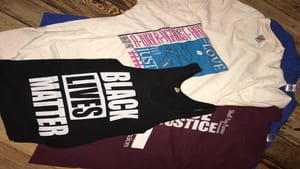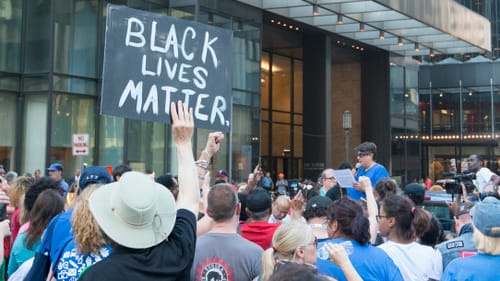Stay in the Loop
BSR publishes on a weekly schedule, with an email newsletter every Wednesday and Thursday morning. There’s no paywall, and subscribing is always free.
Second skin
The shirt off my back

The day the Supreme Court declared marriage equality the law of the land, my teenaged daughter phoned me in a fury.
She was on board with the ruling; the kid has two moms, after all, and agitated for us to marry even before it was legal in Pennsylvania. When we finally did tie the knot (despite my misgivings about the sexist taint of state-sanctioned matrimony), she raised a flute of sparkling cider, alongside her beaming grandparents, during our intimate living-room ceremony.
What had my daughter in a rage that day in 2015 was the social-media surge: jubilant emoticons and Instagram photos filtered with the red-to-violet prism of queer alliance.
“It just makes me so mad,” she groused. “Where were all those people when the fight for gay rights was happening? Did they even care? Now they’re all like, yay, and putting rainbows on everything.”
I did what parents do when they’re awestruck by their kids: I wiped my stinging eyes. I said, “I love you.”
Curating a collection
That conversation came back to me this summer, when my daughter, now 17, asked what I would write if I had to draft my college application essay now. I told her I would write about my Black Lives Matter t-shirt.
It’s a basic tank: the fabric light and breathable, its hip-skimming length just right for a person who is barely five feet tall. It was a gift from a white friend, and for months, it remained in my dresser, third drawer from the top, my go-to spot for “clothes with causes.”
There’s a boxy tee from Oregon’s 1992 Walk for Love and Justice. A soft maroon shirt with my synagogue’s name and a quote from Deuteronomy. A cobalt short-sleeve from a community playground build.
I wear them all, proud to broadcast my allegiances. But for a long time, I shied from adding the Black Lives Matter shirt to my hot-weather wardrobe. It wasn’t political ambivalence; I’ve never doubted the necessity or import of the Black Lives Matter movement. If I did, my African-American friends would quickly shout me straight.
Knowing their struggles made me want to wear the shirt every time I left the house. But was I ready for the sneers of those who would insist “all lives matter”? Would I find the right retort: of course all lives have value, but we live in a nation whose white founders posited—and where many still believe -- some lives matter less. Was I up for the fight?

More than words
Then I remembered: My black friends don’t get to choose which mornings they feel most girded for abuse. Every moment of every day, they’re susceptible to the whole racist gamut, from spirit-crushing comments to lethal police brutality.
Wasn’t it a gesture of solidarity to endure whatever taunts might come my way? Isn’t that what alliance means—a willingness to walk the talk, especially if that walk takes place in someone else’s discomfiting shoes?
This summer, I packed my Black Lives Matter shirt for a road trip to Kentucky and Tennessee. In Paducah, white tourists flicked their gaze to my chest, then looked uneasily away. In Nashville, a young black man collecting for the ASPCA nabbed me with a grin—“Hey, you look like someone I should talk to!”—then tried to qualify his hasty profiling. “I mean,” he stammered, pointing at my shirt, “you’re, uh, wearing black. I’m wearing black. Where are you from?”
Half an hour later, as we trudged to our car, an older black man called out from a doorway, “Got a dollar?” When I walked on, gaze locked to the pavement, he added, “I mean, you say black lives matter, so…?”
My shirt signaled disruption; it signaled solidarity. It opened conversations and shut them down. I felt proud to wear it as I crossed the John Seigenthaler Pedestrian Bridge, named for a Nashville journalist and civil rights advocate. I felt ashamed to wear it as I brushed past a homeless man without looking him in the eye.
Learning humility
At age 14, my daughter understood how quickly a revolutionary flag can become a fashion statement, how capitalism snatches the emblems of resistance (Rainbow party hats from Target, anyone?) and renders them mainstream.
A commitment to people of color has to be more than window dressing. It’s easy to put on a shirt. It’s hard to check my own white privilege. It’s harder to remain a humble ally, to listen and read and acknowledge how much I still must learn.
Some days, I don’t deserve to wear that shirt. Other days, it’s a spur to work ceaselessly for racial justice.
One recent morning, I was crossing a busy street when a 30-something black man, smiling broadly, gestured toward the slogan I’d forgotten I was wearing. “Thank you,” he said.
Later, I washed my Black Lives Matter tank by hand and slung it over the shower bar to dry. The cotton is already thinning, and the dryer’s heat can sear. I want my shirt to last. I want more chances to live out its declaration, and its promise.
Sign up for our newsletter
All of the week's new articles, all in one place. Sign up for the free weekly BSR newsletters, and don't miss a conversation.

 Anndee Hochman
Anndee Hochman